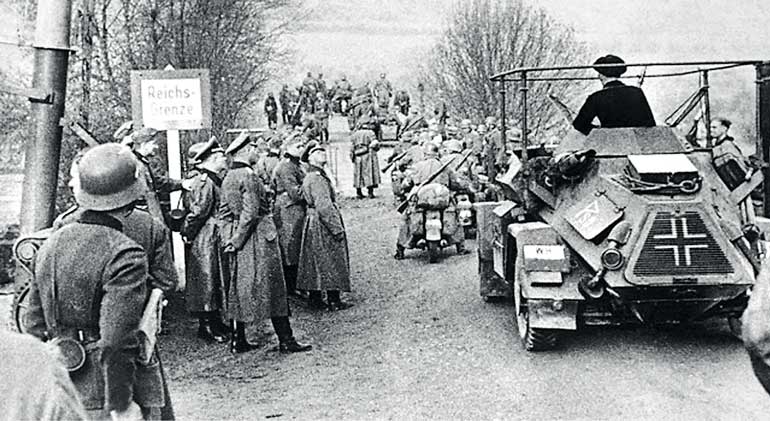Saturday Jan 25, 2025
Saturday Jan 25, 2025
Saturday, 2 July 2016 00:00 - - {{hitsCtrl.values.hits}}

German troops
When the German Army burst into Poland on the first day of September 1939 it became evident to the world that before their anxious eyes was unfolding a superlative performance by an army, with a completely new approach to warfare.
On that day, Adolf Hitler unleashed his soldiers, highly-trained and motivated, on a brave but relatively weak Polish Army, with orders to bring the enemy to heel within the shortest possible time. The real threat to his designs lay miles away, in the Western front where Germany faced the formidable French and Allied armies.
The German forces attacking Poland, just short of two million, were organised in to several armies. Crossing into Poland at strategically picked points along their long border, the newly-created Panzer divisions drove deep, and soon powerful German units were in the interior of the massed Polish forces, thus compelling the Poles to fight on all sides; enemy in the front as well as their  rear, a hopeless situation for a large army.
rear, a hopeless situation for a large army.
Until then it was not thought possible to handle armies on such rapid manoeuvres, a feat the Germans achieved that September. The unprecedented mobility of the attacking forces decided the issue within days, once again proving the vaunted military skills of the Teutons. After the initial break-through, the final result was never in doubt, the only question being the length of time the Poles would hold on for in the face of the severe punishment meted out to them.
The Panzer divisions, which had moved rapidly over the flat countryside of Poland, were relentless in attacking the rear areas of the Polish Army, hampering any attempts at regrouping while the German Air Force mercilessly bombed the desperate defenders, pinning them down. By 28 September, the battle was virtually over.
First World War
Centuries before, Roman legions patrolling the then dark uncharted northern forests of Europe encountered the robust and fearsome Germanic tribes that inhabited those parts, eventually coming to dread them. Through the succeeding centuries these tribes (taken broadly, they include the Celts, Normans so on) evolved, gradually uniting into powerful nations.
They were a gifted people and acquitted themselves very well, becoming accepted leaders in science, technology, literature, philosophy and even music. But it seems that the smouldering fires of atavistic belligerence, burning deep in the hearts of the fierce tribesmen, were not fully extinguished in the long civilising process.
Confirming their inherent militarism, in 1914 the Tutons ignited the First World War (1914-18), engulfing the whole of Europe in an inferno lasting four long years. The powerful cannons of that conflict blew away for good the existing world order, which at the time seemed everlasting. Only the massive intervention of the Americans on the side of the Allies tilted the balance against the formidable German Army. The universal disorder that followed this unprecedented blood bath led to the creation of both the Communist government in Russia, as well as eventually, in 1933, Adolf Hitler in Germany.
Formidable force
Germany’s speedy triumph against the Poles in September 1939 highlighted the menace that this capable, aggressive race, rearmed under Hitler now posed. Armoured Divisions, carrying formidable firepower and designed for rapid mobility were going to be the cutting edge of their mighty sword. The thrusting Armour would be closely supported by deadly accurate German artillery, effectively augmented by the devastating air power of the Luftwaffe. Like in the earlier war, this formidable military machine drew heavily on the brilliant leadership provided by its outstanding General Staff. And above all, the ordinary German soldier, strong, capable and disciplined was ready to answer the call to arms.
Having vanquished Poland, Hitler had to then deal with France, and their ally, the supporting British forces in the West. In training and capability these forces were perhaps on par with the Germans, while in equipment even marginally stronger, though perhaps not as effectively disbursed or utilised as the latter. But most importantly, in spirit and commitment, as events would reveal, the Allies were nowhere near the martial Germans.
Change of plan
In 1940, most of the German General Staff officers involved in planning of the impending attack on the Western front had experienced their baptism of fire in the First World War (1914-18) as junior officers. Despite their recent success in Poland, and new military methods evolved in the intervening 25 years, many of them were yet powerfully influenced by that gigantic struggle in the muddy plains of Western Europe in their youth.
France, an advanced nation possessed of a powerful army, was not Poland. They argued that the way to bring the powerful French Army down was by launching an attack through the low-countries, Holland and Belgium, bypassing the formidable Maginot Line, with the strategic aim of seizing vital areas of the Channel coast early.
Their plan envisaged first destroying the large enemy formations based in northern France, including the British forces there, and eventually making it untenable for the remaining French forces to resist. Notwithstanding the various allowances for technological advances in military science since, this was conceptually a near repetition of the German plan of the First World War.
Some among the senior planners however were dissatisfied with the limited scope of the plan offered by the Army High Command. They were of the opinion that the enemy’s undoubted strengths were the very reason why the Germans should deliver a fatal blow before those strengths could be fully mobilised and brought to bear on the battlefield.
Von Manstein, a relatively junior officer then, wrote with chilling professionalism of the proposed plan: “I found it humiliating, to say the least, that our generation could not do nothing better than repeat an old recipe, even when this was the product of a man like Schlieffen. What could possibly be achieved by turning up a war plan our opponents had already rehearsed with us once before and against whose repetition they were bound to have taken full precaution?”
The dissenters suggested instead a more daring plan, which envisaged the main thrust to be driven through the difficult terrain of the Ardennes, while the attack through the low-countries was essentially a secondary attack as a way of drawing away the enemy forces. The proponents of the second plan argued that the French least expected an attack through the Ardennes and if an initial impetus could be gained there she could be fatally wounded. When the mobile German units emerged out of the Ardennes forest deep in France, splitting the French forces in two, they would be in the rear of the French forces facing the low-countries for the anticipated German attack there.
To overcome the geographical challenges the Ardennes forest posed, the dissenters proposed utilising newly-acquired capabilities, including tracked vehicles, predominantly the proven Panzers, bridge building capabilities and of course radio equipment. Famed Tank commanders like General Guderian saw the exciting possibilities this somewhat unorthodox idea presented, while the much respected Colonel General Von Rundstedt who was in the highest ranks of the Army, after some hesitations, whole heartedly endorsed the daring plan.
It is testimony to the selfless professionalism and the cold rationality of the German Army that an audacious plan suggested only by a minority of officers came to be endorsed over the former plan, which had been proposed by the hierarchy. Hitler, the evil genius, very open to new ideas in such matters, also became an ardent enthusiast.
The stage was now set for one of the most swift and decisive military victories of modern era.
Complacent French
While a resurgent German Army was preparing for the attack purposefully, the French side was remarkably complacent. The Chief of her army was the 68-year-old General Maurice Gamelin who epitomised the axiom that no man is in a hurry to conclude that the skills and knowledge he has devoted a lifetime to acquire are obsolete. He did not think that air power would play a significant role in modern warfare and belittled the importance of radio communication, refusing to have a radio in his headquarters, fearing it might reveal its location to the enemy. When questioned about the length of time he took to communicate his orders to the frontlines, Gamelin’s casual answer was 48 hours!
Had Gamelin an inkling of the catastrophic defeat ahead for France he would not have been that nonchalant. While the French commander was finding comfort in wishful thinking, the Wehrmacht was planning in secrecy a campaign of unprecedented velocity against Gamelin’s weakest flank. The German attack was to be led by the powerful Panzer divisions closely supported by a tireless Luftwaffe.
Unlike the French, the Germans fully embraced modern technology, using radio communication to coordinate and direct the attack. Gamelin’s failure to appreciate the huge potential of air power proved to be just as disastrous as his decision to disperse his armoured strength in an infantry support role, thus leaving the task of countering the powerful thrusts of the German Panzer divisions to formations still arranged in the mode of the earlier war.
One strong drive
The Wehrmacht was determined to cut through France in one strong drive, which would leave the enemy in a hopeless situation. Much thought were given to the composition of the Panzer divisions and the tactics of the advance. The number of Panzers in the establishment, the supporting artillery, the infantry component and the all-important engineers attached to an attacking division were decided primarily on the need for maximum speed and logistical coherence.
Nothing was to interfere with the speed of the advance. When serious resistance was encountered, more often the infantry were sent in to deal with it; the Panzers kept moving forward to a pre-determined schedule. The determination of the Germans to gain a decisive ascendancy in the narrow attack frontage of the Ardennes can be assessed from the galaxy of high calibre officers who held command in this sector. Led by Colonel General Rundstedt they included Generals of the quality of Guderian, Kleist, Reinhardt, Hoth and Rommel.
The attack, which began on 10 May 1940, had achieved most of its goals by the 27 May by which day the British had begun evacuating their forces from Dunkirk. The German Army in little more than two weeks had more or less defeated France, a major world power. In comparison, in the First World War, despite their super-human efforts, the Germans could not take Paris, ending that mighty battle in a bloody stalemate after four years of continuous fighting.
Having vanquished France, Hitler was the master of mainland Europe. He had to now decide on invading Britain or to go east to settle the issue with the despised Slavic nation of Russia once and for all. After a half-hearted effort at subduing the proud island across the narrow English Channel with air power, Hitler turned his eyes eastward to Russia, leading to the epic struggle that were to determine the fate of the Third Reich.